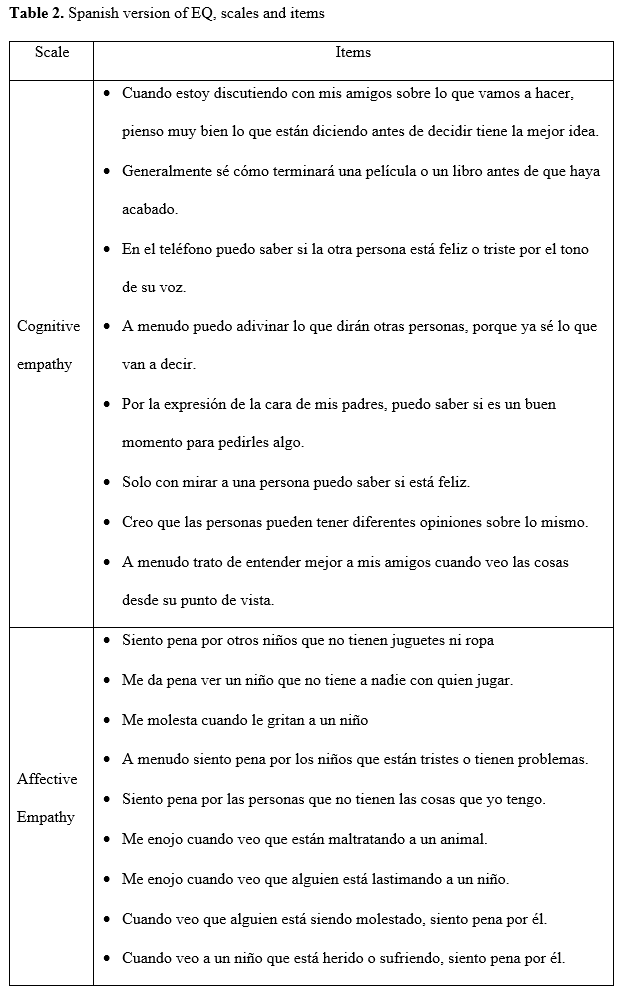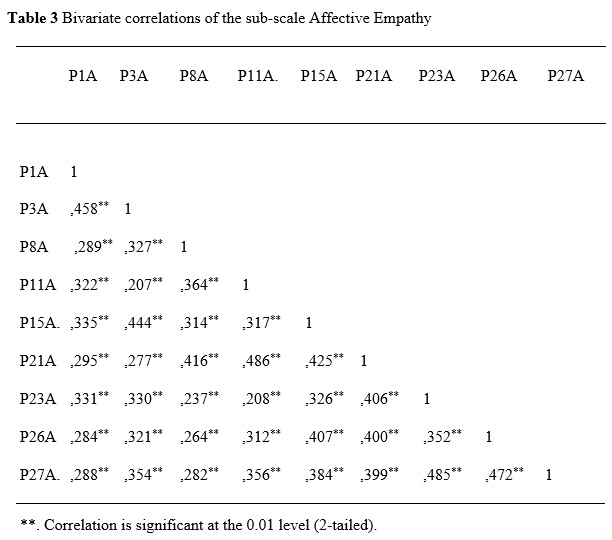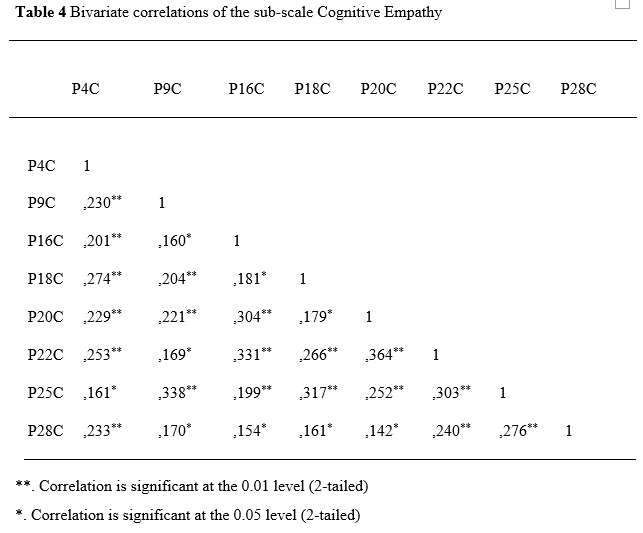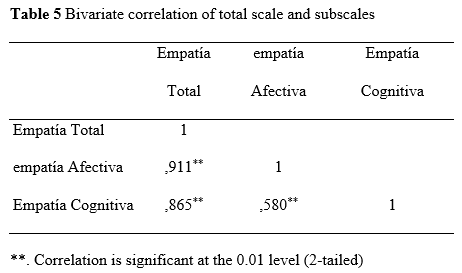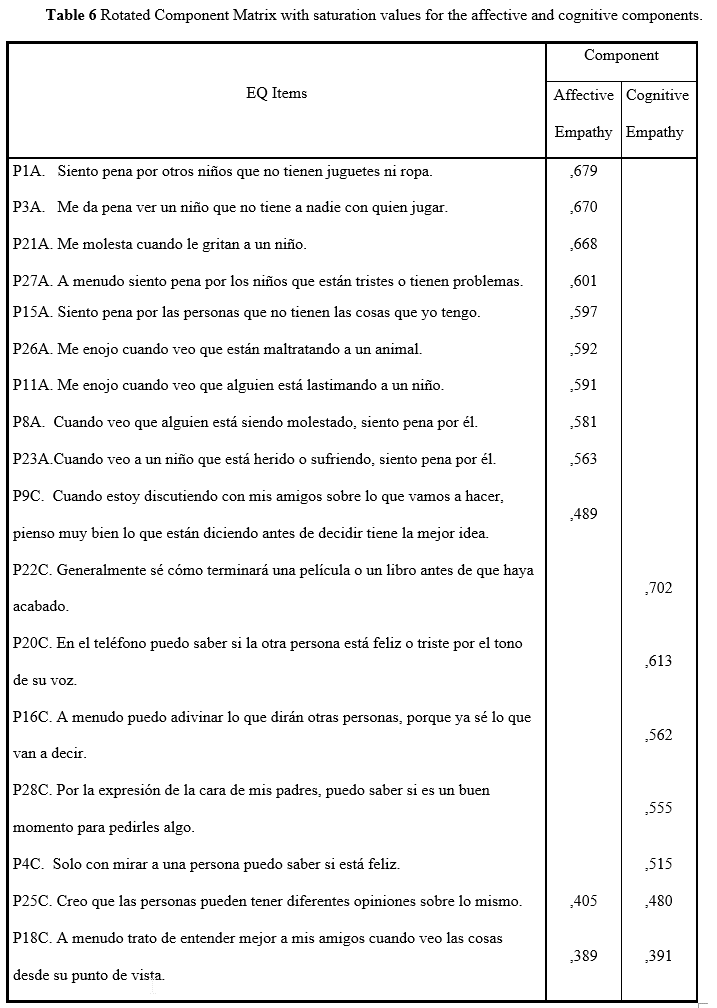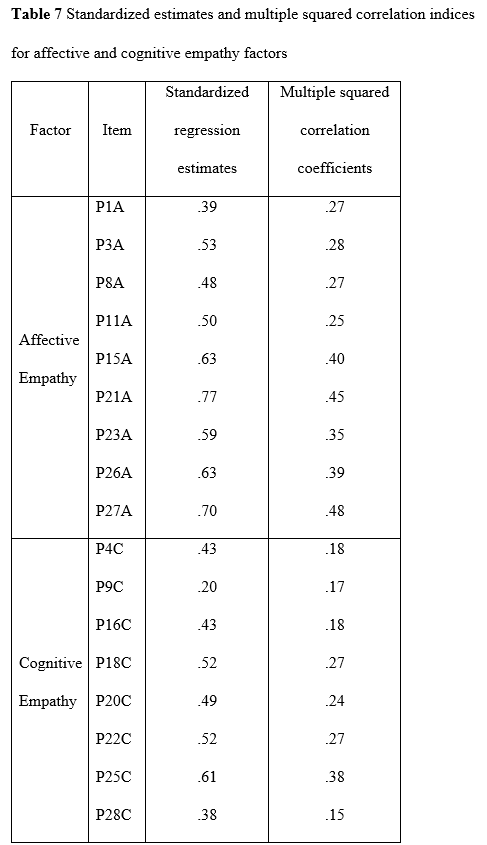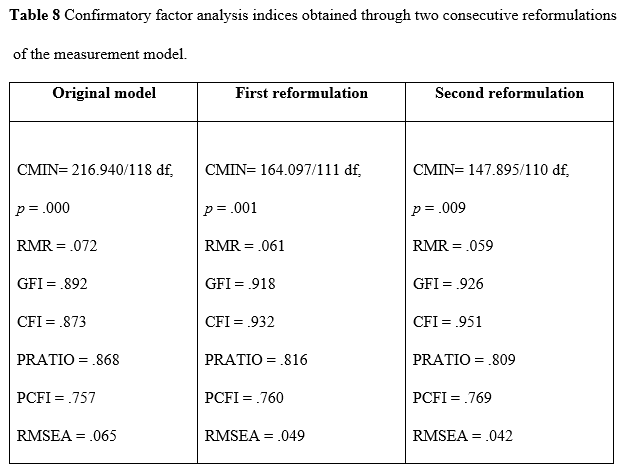Servicios Personalizados
Revista
Articulo
Indicadores
-
 Citado por SciELO
Citado por SciELO -
 Accesos
Accesos
Links relacionados
-
 Similares en
SciELO
Similares en
SciELO
Compartir
Ajayu Órgano de Difusión Científica del Departamento de Psicología UCBSP
versión On-line ISSN 2077-2161
Ajayu vol.18 no.1 La Paz mar. 2020
ARTÍCULO
ADAPTACIÓN AL ESPAÑOL Y ADAPTACIÓN DEL CUESTIONARIO DE EMPATÍA DE ZOLL Y ENZ'S EN NIÑOS BOLIVIANOS
SPANISH ADAPTATION AND VALIDATION OF THE ZOLL & ENZ´S EMPATHY QUESTIONNAIRE IN BOLIVIAN CHILDREN
QUESTIONÁRIO DE EMPATIA EM CRIANÇAS BOLIVIANAS
Eric Roth[1]
Unidad de Investigación Experimental UIE
Universidad Católica Boliviana “San Pablo”
ABSTRACT.
The aim of the present paper is to adapt and validate the Empathy Questionnaire (EQ) designed by Zoll & Enz (2005), in a sample of Bolivian children, aged between 8 and 14 years. The original questionnaire was designed to measure both cognitive and affective empathy through 28 items in a five-point scale distributed in two factors. The EQ adapted and validated in Bolivia was reduced to 17 items, nine to measure the affective scale and 8 to assess the cognitive scale. With this structure, the instrument showed adequate values of reliability and factorial validity which leads us to confirm that the EQ is an adequate instrument to measure the empathy in this population. Likewise, the confirmatory factorial analysis also showed an adequate adjustment of the metric model with acceptable values of model fit, adequate parsimony and especially, a Root Mean Square Error of Approximation (RMSEA) that satisfies the minimum requirements of adjustment to the population covariance matrix.
Key Words: Empathy Questionnaire, adaptation, validation, Bolivian children.
RESUMEN.
El objetivo del presente trabajo es adaptar y validar el Cuestionario de Empatía (CE) diseñado por Zoll y Enz (2005), en una muestra de niños bolivianos de entre 8 y 14 años. El cuestionario original fue diseñado para medir empatía cognitiva y afectiva a través de 28 ítems en una escala de cinco puntos distribuidos en dos factores. El EQ adaptado y validado en Bolivia se redujo a 17 ítems, nueve para medir la escala afectiva y 8 para evaluar la escala cognitiva. Con esta estructura, el instrumento mostró valores adecuados de confiabilidad y validez factorial, lo que nos lleva a confirmar que el EQ es un instrumento adecuado para medir la empatía en esta población. Asimismo, el análisis factorial confirmatorio también mostró un ajuste adecuado del modelo métrico con valores aceptables de ajuste del modelo, parsimonia adecuada y, especialmente, un Error Cuadrático Medio de Aproximación (RMSEA) que satisface los requisitos mínimos de ajuste a la matriz de covarianza poblacional.
Palabras clave: Cuestionario de Empatía, adaptación, validación, niños bolivianos.
RESUMO
O objetivo deste trabalho é adaptar e validar o Empathy Questionnaire (CE) elaborado por Zoll e Enz (2005), em uma amostra de crianças bolivianas entre 8 e 14 anos. O questionário original foi projetado para medir a empatia cognitiva e afetiva através de 28 itens em uma escala de cinco pontos distribuídos em dois fatores. O QE adaptado e validado na Bolívia foi reduzido para 17 itens, nove para medir a escala afetiva e 8 para avaliar a escala cognitiva. Com essa estrutura, o instrumento apresentou valores adequados de confiabilidade e validade fatorial, o que nos leva a confirmar que o EQ é um instrumento adequado para medir a empatia nessa população. Da mesma forma, a análise fatorial confirmatória também mostrou um ajuste adequado do modelo métrico com valores aceitáveis de ajuste do modelo, parcimônia adequada e, principalmente, um Erro de Abordagem do Quadrado Médio (RMSEA) que atende aos requisitos mínimos de ajuste da matriz de covariância populacional.
Palavras-chave: Questionário de empatia, adaptação, validação, crianças bolivianas.
Empathy is not a unique concept with an invariable meaning. Different disciplines use it to facilitate the understanding of some of its phenomena related to the interpretation of one's own and others' affective states. Certain notions related to the concept of empathy could have arisen more than a century ago linked to the aesthetic expression when, for example, it was sought to explain why the contemplation of an artistic masterpiece moves us so deeply to the point of tear us or leaving us without breath, or when we try to explain the commotion caused by the experience of desolation of a degraded ecosystem or the loss of animal and plant species by human negligence. Both emotional expressions explained with the same term are undoubtedly different but share the fact of tempering the intimate fibers of certain people.
From the point of view of psychology, the notion of empathy has seen the light through the eyes of the phenomenology of Theodor Lipps at the beginning of the last century. Lipps, in the words of Sahavi & Overgaard (2012) understood empathy as the product of a projection of our own feelings, evoked by others; a kind of somato-sensory imitation similar to emotional contagion. It would be an inter-subjective experience, something like an "iner seeing" (or "einsehen"in German), an "einfühlung" or "feeling into" that Titchener (1909) would later describe with the Greek term "in-pathos", empathy in English.
More recently, but also from the phenomenology point of view, De Vignemont & Singer (2006), emphasized the isomorphic property of empathy which means that the affective states of the empathic observer and those of the other person are topographically equivalent. In this way, the following requirements should be met: It should imply an affective state of the observer, similar to that of the other person. This state would be produced by direct observation by the observer who notices the existence of the affective state in the other person, and who also recognizes it as the source or origin of their emotional reaction. According to Zahavi and Overgaard (2012) this proposal does not allow differentiating empathy from other similar reactions such as sympathy and emotional contagion. These authors also questioned the assumed isomorphism of empathy and criticized its experiential nature with the argument that it is not possible to have access to another person experience. Likewise they assume, with Bennet and Hacker (2003) that the only evidence that can be obtained from the affective state of others is through the inference that allows the observation of the behavior associated to the expression of such affective state. The authors point out that we can infer pain if we observe the other person taking analgesics or writhing in pain. In the same way, we can assume that the person suffers a sorrow if we observe some signs on his face (such as certain expressions accompanying crying, for example) or body postures (such as those that usually accompany feelings of helplessness), etc.
On the other hand, Batson (2012) defines empathy as "empathic concern", implying that this construct should be understood as an emotional response to the other´s suffering. Also, Batson's position emphasizes empathy as a means to understand altruistic behavior in what he called "the empathy-altruism hypothesis" (Batson, 2009). The author offers a definition of empathy emphasizing what the construct is not: empathy is not knowing the feelings and thoughts of others, it is not adopting the posture of another's neurological response, it is not feeling what the other feels. Nor is feeling discomfort or anguish when observing the suffering of the other, or imagine what one could think or feel in the other's place. Empathy does not suppose, according to Batson, to imagine what another feels or thinks and it is not a trait or general disposition to feel what others feel. Empathy is the concern that leads to help the needy from an altruistic perspective after developing empathic comprehension that allows understanding the affective state of the other person (Echols & Correll, 2012).
Despite the diversity of conceptions, various authors (Eisenberg et al 1994, Eisenberg, Espinrad & Sodowsky, 2006, Hoffman, 2000, Vaish & Warneken, 2012) agree on defining empathy as an affective response that arises from the understanding of another's emotional state and which is very similar to it. Hence, it would seem reasonable to understand empathy from two dimensions: the cognitive and the affective dimensions. The first one has to do with the series of operations related to the reading and interpreting the complex expressive signals emerging from the person, from their immediate context and its meaning, allowing obtaining a concrete knowledge about the emotional state of the person. These operations are based on the knowledge that the observer has of his/her own emotional reactions, their determinants and consequences, as well as of the stimuli that predispose and produce them. Cognitive empathy is therefore related to the taking of perspective, understood as a series of inferences that the observer makes about the emotional state of the other, putting himself in his place and making inferences about his emotionality (Eisenberg et al., 1991) and imagining himself in a different situation (Decety & Sommerville, 2003).
The affective dimension of empathy would come out as a consequence of the cognitive verification of affective signals that evoke similar emotional responses in the observer and move him to behave in the same direction.
The measurement of children's empathy.
Miller & Eisenberg (1988), Zhou, Valiente & Eisenberg (2003) described four common methods of measuring affective and cognitive empathy in children. These methods are the following:
A first group of instruments seeks to measure the perceptions and recognition of the emotions expressed by children using stories, drawings or videos. The problem with this modality is that the recognition of emotions by itself does not allow us to measure the degree of understanding of the complex contextual conditions of empathic emotion.
Other instruments use drawings or stories that would allow children to interpret the emotional situation of other people. These are made known through self-reports or interview formats. Here the problem lies in the simplicity of the stimuli used in the instrument. Generally, the stimuli that they incorporate do not allow us to recreate the true complexity of the scenario that arouses empathic concern.
In the third place are the questionnaires or scales under the self-report modality that are the most widespread means of measuring empathy. In this group of measures, the biases and the expectations of both, the evaluator and the evaluated, are the problems mostly reported as invalidation conditions. Likewise, the insufficient development of the children language and their natural difficulties of abstraction may play against the proper understanding of the story or of the items that evaluate empathy. Similarly, such limitations hinder the clarity and sharpness of their response.
However, the paper and pencil self-assessment questionnaire is the most widely disseminated data collection tool in empathy research, especially where it is studied in relation to other relevant variables (Feshbach & Feshbach, 1969; Litvack-Miller, McDougall, & Romney, 1997; Kestenbaum, Farber, & Stroufe, 1989; Eisenberg, Eisenbud, & Fabes, 1993; Garton & Eyal Gringart, 2005).
Finally, a fourth group of instruments includes psychophysiological measures of the emotional response. These measures, while solving some of the aforementioned problems faced by the other mechanisms, are often not very sensitive to discriminate, for example, between empathy, sympathy or other more subtle expressions associated with finer cognitions. Its invasiveness and high cost are also difficulties faced by this group of measures.
About the original version of Empathy Questionnaire (EQ)
The purpose of this research was to adapt and validate the EQ designed by Zoll & Enz (2005) for children, to measure this construct in a Bolivian sample.
The original questionnaire was designed to measure both, cognitive and affective empathy through 28 items in a five-point scale (from 1: “I strongly agree” to 5: “I strongly disagree”). For the construction of this version, the authors reported that of the chosen items, some were taken from other known instruments, while others were specially designed for EQ. The instruments that served as the basis for the construction of the EQ were: the Index of Empathy Measurement for Children and Adolescents (Bryant, 1982), which in turn is a revision of the Mehrabian & Epstein's (1972) used for adults. We also took items from the E scale of Leibetseder et al, (2001); and of the adaptation made by Garton and Gringart (2005) of the Index of Interpersonal Reactivity (IRI) of Davis (1980, 1983). Finally with validation purposes, EQ received six additional items from Eisenberg & Fabes (1998). The EQ data was collected from children of both sexes of United Kingdom, Germany and Portugal (N = 623) with ages ranging from eight to fourteen years (M = 9.90; SD = .92).
The authors did not report reliability or validity information concerning EQ. However, they pointed out that no appreciable differences were found between the three countries and that exploratory factor analysis suggested two factors (cognitive empathy with 12 items and affective empathy with 10 items), both explaining with 31.19% of the total accumulated variance. The exploratory analysis discarded, in turn, all the items written negatively, so that the test counted in its final version with only 22 items. Table 1 presents the structure of the original EQ.
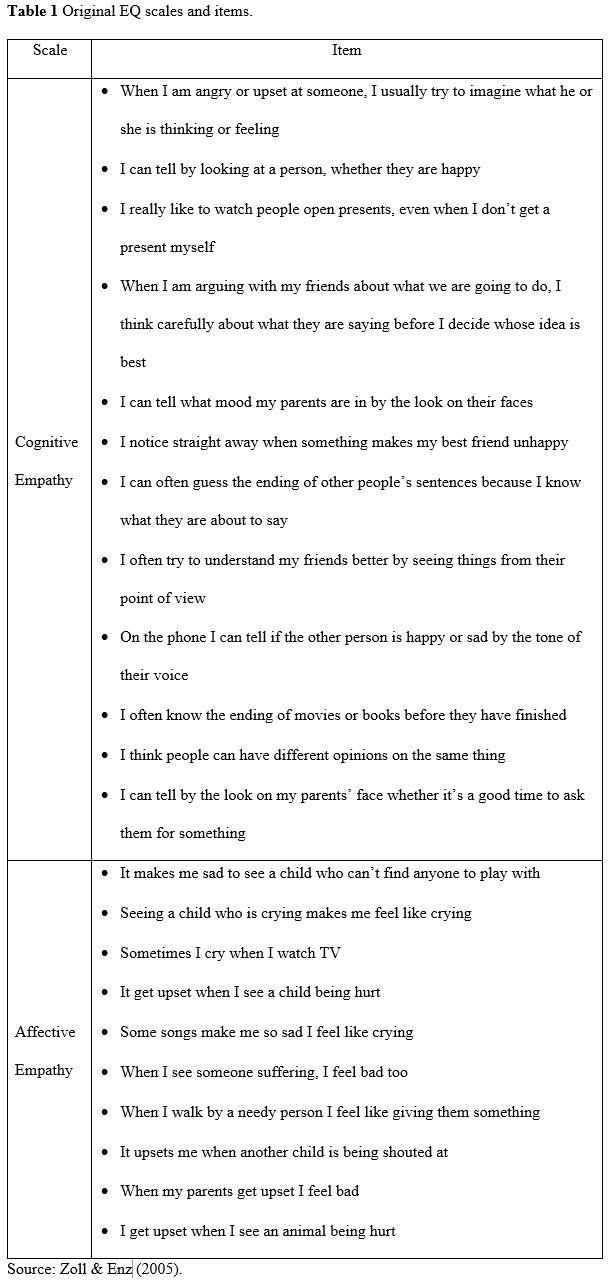
Method
Participants. In the present adaptation, the authors tested the complete EQ (the 28 items studied by Zoll & Enz (2005). The instrument was first translated into Spanish, back-translated into English for comparative purposes, and then applied to a sample of 200 children aged between 8 and 14 years. The mean age of the sample was 10.94 with a standard deviation of 1,929. Ninety-nine were males (49.5%) and 101 females (50.5%). Before the final procedure of sample selection, informed consent was obtained both from their parents and from the staff of the participating school. The application of the EQ was carried out at the school classrooms during the regular class periods.
Before applying the EQ, the researchers proceeded to test the linguistic and grammatical structure of each item (wording) in order to verify that they were understood by children in the sample. For this purpose, other children with ages similar to those in the sample were invited to participate in focus groups organized by age ranges. In each group, the children read the items on the instrument and explained what they understood about each one. Sometimes they also suggested alternative forms of expression that were more understandable to them.
Before beginning the test at the classroom, the researchers offered the youngest children a brief explanation on how they should respond the questionnaire, providing some examples about the use of the response scale. The application of the instrument began only when there was certainty that the children clearly understood the response modality. When a child persisted in his response difficulties, he was eliminated from the sample and replaced by another. The time of application of the test lasted between 30 and 45 minutes, depending on the age of the participants.
Adapted instrument. The preliminary test carried out with the focus groups suggested the elimination of eleven items that were confusing and difficulting the understanding by most of the children interviewed. The result was a questionnaire with 17 items and two scales, 8 items for the cognitive empathy scale and 9 items for the affective empathy scale; all were written as positive expressions. Each item could be answered on a 5-point scale, where 1 = totally disagree and 5 = totally agree.
Below is Table 2 with the list of items that were finally included for the adaptation of the EQ.
Results
Data exploration. The distribution exploration showed value coincidences between the 5% trimmed mean and the median, slight negative asymmetry (- .140), comparable M-Estimators (Huber = 104.96, Tukey = 105.12, Hampel = 105.06, Andrew = 105.12), acceptable the kurtosis value (-.496) and a good Kolmogorov-Smirnov´s test of normality (.043, p = .200), indicating a relatively normal distribution of EQ data.
Reliability analysis. For 17 items, a Cronbach's Alpha = .850 allowed to conclude an adequate reliability of the instrument. Likewise, the inter-correlations corresponding to the total test and separately, to the two sub-scales, corroborate the internal consistency of the EQ (see Tables 3, 4 and 5).
Exploratory Factor Analysis. The Empathy questionnaire (EQ) was first submitted to the Exploratory Factor Analysis (EFA) on the basis of a bi-factorial structure, following the structural approach of Zoll & Enz (2005). The EFA was made with the Principal Component Extraction Analysis technique (PCEA), seeking to obtain a maximum variance from the set of variables with a minimum of components. Therefore, the PCEA forced the consideration of only two components. The input indicators, the KMO = .851 and the Bartlett Sphericity Test (χ2 = 883.604, p = .000) confirmed the feasibility of the factorial analysis.
The table of communalities shows that with the exception of P4C and P9C, all the other items in the questionnaire explain at least the 30% of the variance in both factors, which confirms the presence of common elements in the instrument.
The decision adopted regarding the number of components involved in the analysis was confirmed by the scree plot that highlights only two eigenvalues differentiated from the rest. In this way, the analysis based on two components allowed to explaining 32.29 percent of the total variance contributed by the 17 items of the questionnaire.
The extraction of the components was performed using the Varimax method with saturation indexes greater than .563 for the items of the affective component and .391 for those of the cognitive component. Note that only one item of the later is charged in the affective component and another two do so in both components, although with higher saturation values for the cognitive component (see Table 6).
Confirmatory Factor Analysis. The Confirmatory Factor Analysis (CFA) of the Empathy Questionnaire (EQ) for children (Zoll & Enz, 2005) hypothesizes that the results obtained can be explained by two factors: affective and cognitive empathy. The modeling, developed with the help of IBM-AMOS (Byrne, 2010; Roth, 2012) assumes that the items measured by the questionnaire load values other than zero. It also assumes that both factors correlate positively.
Unlike the original proposal, the model included only the 17 items that passed the initial comprehension test and that were included in the exploratory factor analysis.
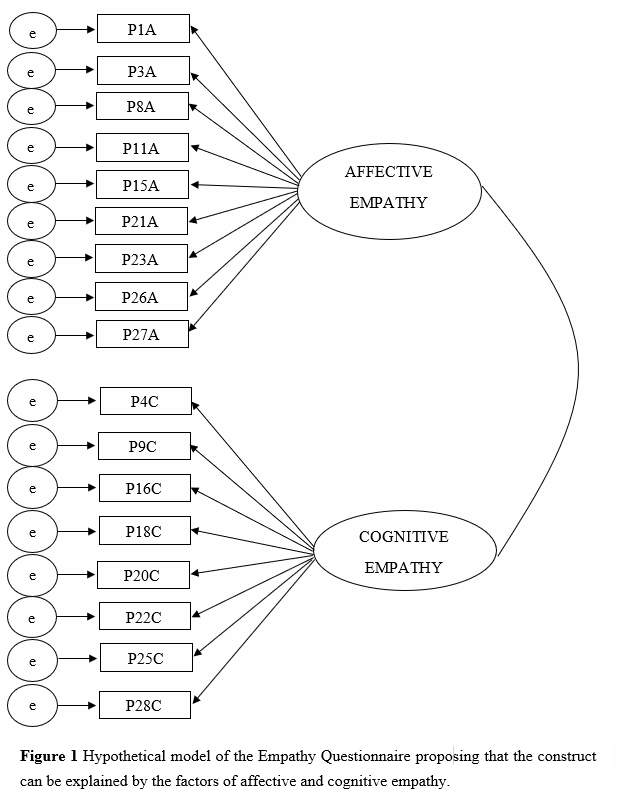
The final model was able to successfully estimate all its parameters. Next Table 7 presents the standardized regression estimates and the multiple squared correlation coefficients.
The standardized estimators show adequate loads for both factors, with values equal to or greater than .39 for affective empathy and .38 for cognitive empathy. Likewise, multiple squared correlation values represent acceptable explained variances.
The present model was adjusted through two reformulations seeking an optimal fit. Below in Table 8 are the model fit indices along the successive reformulations:
Consequently, after two reformulations, we have an acceptable final measurement model (despite the fact that CMIN indicates the impossibility of rejecting the goodness of fit of the model) supported by the RMR (Residual Average Square Root) that reported a value of .059, and a GFI (Adjustment Goodness Index) with a value of .926, close to the optimum of 1.0. Other fit indices (NFI = .838, RFI = .800, IFI = .953, TLI = .940 and CFI = .951) also show an adequate adjustment of the metric model. With regard to the parsimony of the model, the value of PRATIO = .809, reports a relatively simple model. Likewise, the population approximation error RMSEA = .042 satisfies the minimal requirements of fitting.
In addition, for the final reformulated model, the following indicators were obtained: a) Distance of Mahalanobis or centroid distance (D2) that allowed to rule out the existence of atypical values in the distribution, with the exception of observations 36, 39 and 46; and b) HOELTER, that tells us that the results obtained are supported by the size of the sample used in this validation (199, p < .01).
Discussion
The purpose of this research was to carry out the adaptation and validation of the Empathy Questionnaire for children of Zoll & Enz (2005) in a population of Bolivian children, aged between 8 and 14 years. Reliability estimates as well as their factorial validity allowed us to confirm that the EQ is an adequate instrument to measure the empathy of this population through factors such as affective and cognitive empathy. The instrument had to be adjusted eliminating 11 items and making small grammatical adjustments in the writing of some of them. In the EFA, the matrix of rotated components shows that, with the exception of item 9 corresponding to the cognitive component, all the items of the questionnaire saturated well in their respective components. However, the correlations between the affective and cognitive components of the questionnaire are satisfactory, indicating that EQ is a consistent instrument. Finally, the confirmatory factor analysis showed a relatively well-adjusted measurement model after two reformulations, representing adequately, the underlying structure of the EQ.
We can conclude then, that the EQ is a simple and easy measure to be administered to young children. However, the question remains as to whether the structural simplicity of the EQ is capable of representing the true complexity of the empathy construct, whose nature is clearly multidimensional. Some authors concerned with the measurement of empathy (see Davis, 1980, 1983, Carey, Fox, & Spraggins, 1988, Lietz et al., 2011, Reniers, Corcoran, Drake, Shryane, & Völlm, 2011, among others), have suggested that the instruments that measure it should reflect the multidimensionality of the construct incorporating a greater number of factors in them. So, Chrysikou & Thompson (2016) commenting on the properties of the well-known Interpersonal Reactivity Index (IRI) (Davis, 1980), have suggested that in order to measure empathy, the perspective-taking should be incorporated as a more specific component of cognitive empathy, and empathic concern, as well as emotional distress as variations of affective empathy, which implies incorporating more than two components in the factorial structure of the instrument. Likewise, these authors argued that in order to respond to the items that usually measure affective empathy, it is necessary for the person to first use their own cognitive resources to "put themselves in the situation", causing affective empathy to be confused or masked with the cognitive one. In this way, a diminished cognitive response would reduce the response capacity of items that try to measure affective empathy. In other words, when someone puts himself in a specific situation, he/she may give a response that they know very well it is emotionally appropriate without necessarily experiencing it. This situation may reflect cognitive empathy but not necessarily affective empathy, introducing a response bias that affects the reliability of the measurement.
For some authors (Derntl et al, 2010, Krause et al, 2012, Masten et al, 2010, Rameson et al, 2011, Thoma et al, 2011), the problem could be alleviated by the use of complementary neurophysiological and behavioral measures. In any case, future studies on the measurement of empathy should reconsider the complexity of the construct by incorporating into its measurement procedures additional factors that account for the multidimensionality of empathy.
REFERENCES
Batson, C.D. (2012). The empathy-altruism hypothesis. Issues and implications. In J. Decety (Ed.), Empathy. From bench to bedside, (pp 42-54). Cambridge: The MIT Press.
Batson, C.D. (2009). These things called empathy. Eight related but distinct phenomena. In J. Decety & W. Ikes (Eds.). The social neuroscience of empathy, (pp 3-15). Cambridge: The MIT Press.
Bennett, M.R. & Hacker, P.M.S. (2003). Philosophical foundations of neuroscience. Malden, MA: Blackwell Publishing. [ Links ]
Bryant, B. (1982). An Index of Empathy for Children and Adolescents, Child Development, 53, 413-425. [ Links ]
Byrne, B.M. (2010). Structural equation modeling with AMOS. Basic concepts, applications and programming. New York: Routledge. [ Links ]
Carey, J. C., Fox, E. A., & Spraggins, E. F. (1988). Replication of structure findings regarding the Interpersonal Reactivity Index. Measurement and Evaluation in Counseling and Development, 21, 102-105 [ Links ]
Chrysikou, E.G., &Thompson, W.J. (2016). Assessing Cognitive and Affective Empathy through the Interpersonal Reactivity Index: An Argument against a two-factor model. Assessment, 23(6) 769–776. DOI: 10.1177/1073191115599055
De Vignemont F.,Singer, T. (2006). The empathic brain: how, when and why? Trends in Cognitive Sciences,10(10), 435-41. [ Links ]
Davis, M. H. (1980). A multidimensional approach to individual differences in empathy. JSAS Catalog of Selected Documents in Psychology, 10, 85. [ Links ]
Davis, M. H. (1983). Measuring individual differences in empathy: Evidence for a multidimensional approach. Journal of Personality and Social Psychology, 44, 113– 126.
Decety, J., & Sommerville, J. A. (2003). Shared representations between self and other: A social cognitive neuroscience view. Trends in Cognitive Sciences, 7, 527–533.
Derntl, B., Finkelmeyer, A., Eickhoff, S., Kellermann, T., Falkenberg, D. I., Schneider, F., & Habel, U. (2010). Multidimensional assessment of empathic abilities: Neural correlates and gender differences. Psychoneuroendocrinology, 35, 67-82. doi: 10.1016/j.psyneuen.2009.10.006
Echols, E. & Correll, J. (2012). It is more than skin deep: Empathy and helping behavior across social groups. In J. Decety (Ed), Empathy. From bench to bedside, (pp 55-71). Cambridge: The MIT Press.
Eisenberg, N., & Fabes, R. A. (1998). Prosocial development. In N. Eisenberg (Ed.), W. Damon (Series Ed.), Handbook of child psychology: Vol. 3. Social, emotional, and personality development (5th ed., pp. 701-778). New York: Wiley.
Eisenberg, N., Fabes, R.A., Murphy, B, Karbon, M., Maszk, P., Smith, M., O´Boyle, C. & Suh, K. (1994). The relations on emotionality and regulation to dispositional and situational empathy-related responding. Journal of personality and Social Psychology, 66, 776-797. [ Links ]
Eisenberg, N., Espinrad, T.L. and Sodowsky, A. (2006). Empathy-related responding in children. In M. Killen & J.G. Smetana (Eds.) Handbook of Moral Development, (pp 517-549). Mahwah N.J: Lawrence Erlbaum Ass.
Eisenberg, N., Shea, C. L., Carlo, G., & Knight, G. P. (1991). Empathy related responding and cognition: A “chicken and the egg” dilemma. In W. Kurtines and J. Gewirtz (Eds.), Handbook of moral behavior and development: Vol. 2. Research (pp. 63–88). Hillsdale, NJ: Erlbaum.
Fabes, R. A., Eisenberg, N., & Eisenbud, L. (1993).Behavioral and Physiological Correlates of Children's Reactions to Others in Distress.Developmental Psychology,29(4), 655-663. [ Links ]
Feshbach, N. D., & Feshbach, S. (1969). The relationship between empathy and aggression in two age groups. Developmental Psychology, 1(2), 102-107. http://dx.doi.org/10.1037/h0027016 [ Links ]
Garton, A.F. & Gringart, E. (2005). The development of a scale to measure empathy in 8 and 9 year old children. Australian Journal of Education and Developmental Psychology, 5, 17-25 [ Links ]
Hoffman, M.L. (2000). Empathy and moral development: Implications for caring and justice. Cambridge: Cambridge University Press. [ Links ]
Kestenbaum, R., Farber, E.A., & Sroufe, L.A. (1989). Individual differences in empathy among preschoolers: Relation to attachment history. New Directions for Child and Adolescent Development, 44, 51-64. [ Links ]
Krause, L., Enticott, P. G., Zangen, A., & Fitzgerald, P. B. (2012). The role of medial prefrontal cortex in theory of mind: A deep rTMS study. Behavioral Brain Research, 228, 87-90. doi: 10.1016/j.bbr.2011.11.037.
Leibetseder, M., Laireiter, A.R., Riepler, A. & Köller, T. (2001). E-Skala: Fragebogen zur Erfassung von Empathie - Beschreibung und psychometrische Eigenschaften. Zeitschrift für Differentielle und Diagnostische Psychologie (2001), 22, 70- 85.Obtained from https://doi.org/10.1024//0170-1789.22.1.70.
Lietz, C. A., Gerdes, K. E., Sun, F., Geiger, J. M., Wagaman, M. A., & Segal, E. A. (2011). The Empathy Assessment Index (EAI): A confirmatory factor analysis of a multidimensional model of empathy. Journal of the Society for Social Work and Research, 2, 104-124. doi: 10.5243/jsswr.2011.6
Litvack-Miller W,McDougall D,Romney DM (1997). The structure of empathy during middle childhood and its relationship to prosocial behavior. Genetic, Social and General Psychology Monographs, 123(3):303-24. [ Links ]
Masten, C. L., Eisenberger, N. I., Pfeifer, J. H., & Dapretto, M. (2010). Witnessing peer rejection during early adolescence: Neural correlates of empathy for experiences of social exclusion. Social Neuroscience, 5, 496-507. doi: 10.1080/17470919.2010.490673
Mehrabian, A. & Epstein, N. (1972). A measure of emotional empathy. Journal of Personality, 40(4), 525-543. [ Links ]
Miller, P.A. & Eisenberg, N. (1988). The relations of empathy to aggressive and externalizing/antisocial behavior. Psychological Bulletin, 103, 324-344.Reniers, R. L. E. P., Corcoran, R., Drake, R., Shryane, N. M., & Völlm, B. A. (2011). The QCAE: A questionnaire of cognitive and affective empathy. Journal of Personality Assessment, 93, 84-95. doi: 10.1080/00223891.2010.528484 [ Links ]
Rameson, L. T., Morelli, S. A., & Lieberman, M. D. (2011). The neural correlates of empathy: Experience, automaticity, and prosocial behavior. Journal of Cognitive Neuroscience, 24, 235-245. [ Links ]
Roth, E. (2012). Análisis multivariado en la investigación psicológica. Modelado predictivo y causal con SPSS y AMOS. La Paz: SOIPA. [ Links ]
Titchener, Edward B.(1909). Lectures of the Experimental Psychology of Thought Processes, New York, Macmillian, 1909. [ Links ]
Thoma, P., Zalewski, I., von Reventlow, H. G., Norra, C., Juckel, G., & Daum, I. (2011). Cognitive and affective empathy in depression linked to executive control. Psychiatry Research, 189, 373-378. doi: 10.1016/j.psychres.2011.07.030
Vaish, A. & Warneken, F. (2012). Social-cognitive contributions to young children´s empathic and prosocial behavior. In J. Decety (Ed), Empathy. From bench to bedside, (pp 131- 146). Cambridge: The MIT Press.
Zahavi, D& Overgaard, S(2012).Empathy without isomorphism: A phenomenological account. In J. Decety (ed.),Empathy: From Bench to Bedside, (pp 3-20).MIT Press, Cambridge.
Zhou, Q., Valiente, C., & Eisenberg, N. (2003). Empathy and its measurement. In S. J. Lopez & C. R. Snyder (Eds.),Positive psychological assessment: A handbook of models and measures(pp. 269-284). Washington, DC, US: American Psychological Association. http://dx.doi.org/10.1037/10612-017
Zoll, C., Enz, S. (2005).A questionnaire to assess affective and cognitive empathy in children. Journal of Child Psychology, 15,165-174. Google Scholar. [ Links ]
Recibido: 13 de noviembre del 2019
Aceptado: 14 de enero del 2020
SIN CONFLICTOS DE INTERÉS













